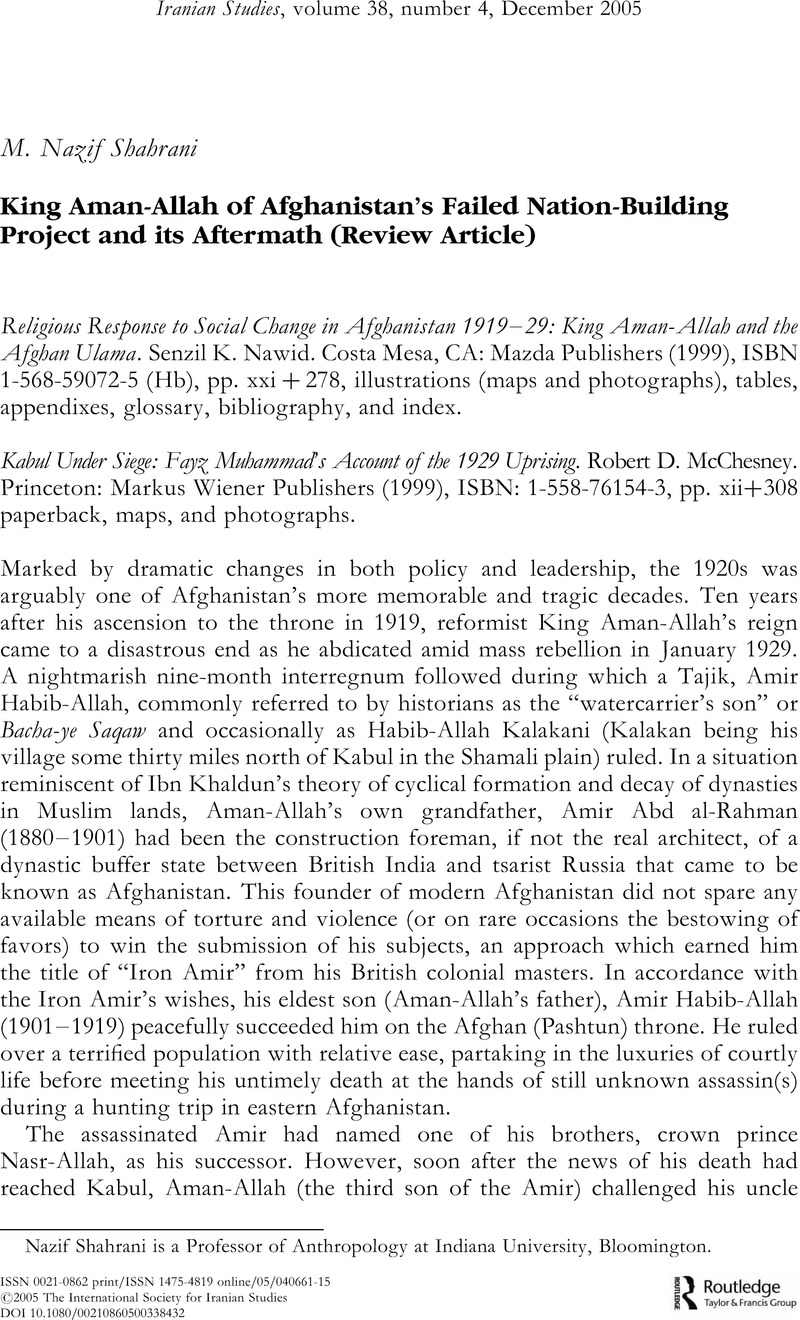Published online by Cambridge University Press: 01 January 2022

1 See, for example, Abd al-Mohammad, Aman al-Tawarikh, “History of Aman-Allah's Era,” 9 vols., (unpublished manuscript deposited in New York University Library); Adamec, Ludwig, Afghanistan's Foreign Affairs to the Mid-Twentieth Century (University of Arizona Press, 1974)Google Scholar; Aziz al-Din Wakil Fofalzai, Negahi ba tarikh-e esterdad-e esteqlal-e Afghanistan (A Glance at the History of Restoration of Independence of Afghanistan), (Government Printing House, Kabul 1368/1989); Safarha-ye Ghazi Aman-Allah Shah dar dawazdah keshswar Asia wa Orupa, 1306–1307 (The Travels of Ghazi King Aman-Allah to Twelve Asian and European Countries) (Government Printing House, Kabul, 1364/1985); Poulada, Leon, Reform and Rebellion in Afghanistan: King Amanullah's Failure to Modernize a Tribal Society (Ithaca and London, 1973)Google Scholar; Shah, Iqbal Ali, The Tragedy of Amanullah (London, 1933)Google Scholar; Stewart, Rhea T., Fire in Afghanistan, 1914–1929: Faith, Hope, and British Empire (New York, 1973)Google Scholar; and Wild, Donald, Amanullah: Ex-King of Afghanistan (Quetta, 1978)Google Scholar. There are also many chapters on the general histories of Afghanistan covering Aman-Allah's reign.
2 The available studies include an alleged autobiography of Habib-Allah [Kalakani] (Amir of Afghanistan) entitled My Life from Brigand to King (London, 1936); Muhyi al-Din Anis, Bohran wa nejat (Crisis and Deliverance), Kabul: Anis newspaper, nd; and Burhan al-Din Kushkaki, Nadir-e Afghan (Nadir, the Afghan), (Kabul 1310/1931). The last two are from the perspective of the Musaheban victors and their activities in the south and east and are written by court journalists. Khalil-Allah Khalili, Afghanistan's most famous poet and literati during the twentieth century and a minor official during the interregnum, has written the only sympathetic account of the Tajik leader in a semi-fictional narrative, ‘Ayyari az Khorasan: Habib-Allah khadim-e din-e Rasul-Allah (A Hero from Khorasan: Habib-Allah the Servant of the Religion of the Messenger of Allah), published in Pakistan during the anti-Soviet resistance (1983). Another account also published in Pakistan (1984) by Shah Agha Mojaddedi is called Habib-Allah khadem-e din-e Rasul-Allah (Habib-Allah, the Servant of the Religion of the Messenger of Allah).
3 Taken as the beginnings of political awakening in the country, all later democratic movements have been inspired by the activities of this group and the topic has been treated extensively by Afghan historians such as Mir Ghulam Mohammad Ghubar, Afghanistan dar masir-e tarikh (Afghanistan in the Course of History) (Kabul, 1967); Abdul Hay Habibi, Junbesh-e mashrutiyat dar Afghanistan (Constitutional Movement in Afghanistan), (Kabul, 1364 H); Hashimi, Said S., Constitutional Movement in Afghanistan, vol. 1, (Stockholm, Sweden, 2001)Google Scholar.
4 This broken promise to the Amir of Bukhara and anti-Bolshevik Turkistani fighters may have been one of the reasons for lack of support for Aman-Allah later during his reign. See Shahrani, Nazif, “Resisting the Taliban and Talibanism in Afghanistan: Legacies of A Century of Internal Colonialism and Cold War Politics in A Buffer State,” Perceptions: Journal Of International Affairs 4 (Ankara, Turkey, 2000): 121–140Google Scholar.
5 See the Appendix B Annotated Amendment of January 28, 1925, (Dalw, 1303): 11–12 at < http://www.afghangovernment.com/Constitution1923.htm>
6 Once again, it reminds us of the problem confronting Mr. Karzai at the moment in his not-so- successful attempt at taming the Taliban and their Pashtun tribal supporters in the east, south, and southwestern region of the country.